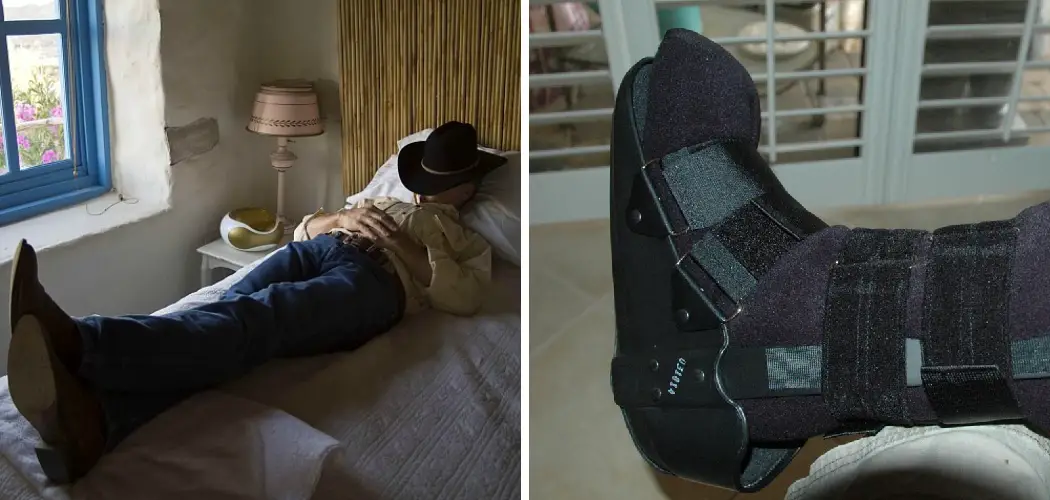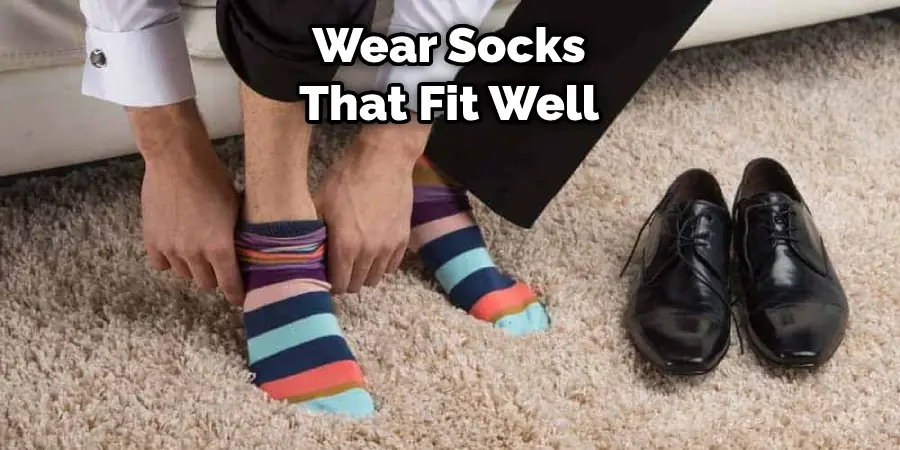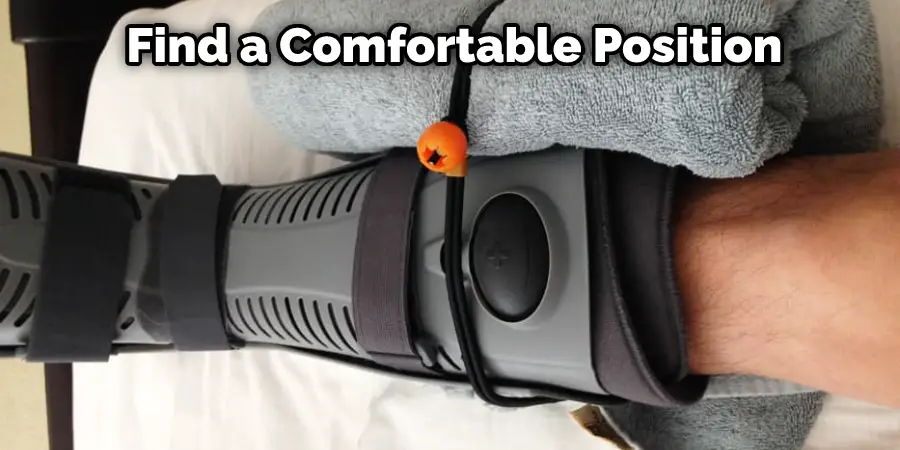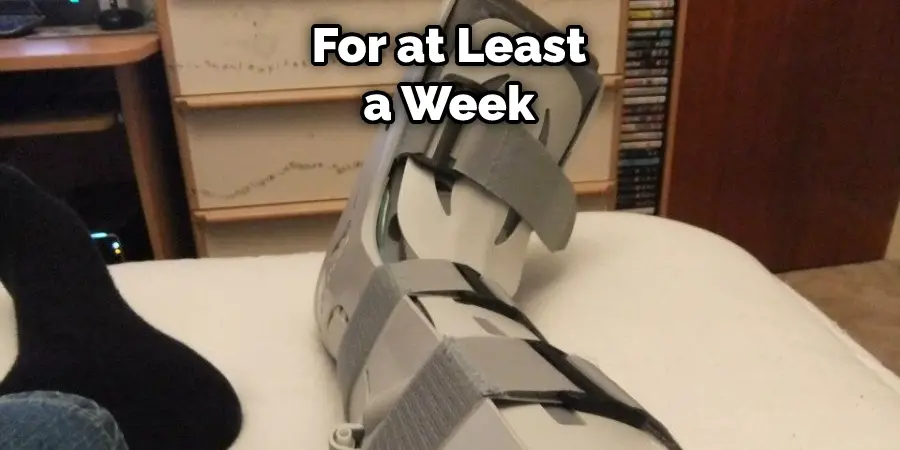When you have a boot on your foot, sleeping can be uncomfortable. However, there are some things you can do to make sleeping with a boot on easier. A boot can help protect an injured ankle or foot and provide added support and stability when walking.

This post will share tips on how to sleep comfortably with a boot on. We will also provide information on choosing the right boot type for your needs. So if you’re looking for ways to make sleeping with a boot more comfortable, read on!
Can You Sleep Comfortably With a Boot on?
If you have a boot on your foot, sleeping can be uncomfortable. However, there are some things you can do to make sleeping with a boot on easier. A boot can help protect an injured ankle or foot and provide added support and stability when walking. This post will share tips on how to sleep comfortably with a boot on.
If your boot is uncomfortable, try sleeping with a pillow under your ankle and foot. This will help elevate your foot and reduce pressure on the boot. You can also try sleeping with a blanket over your calf to support your leg. If you find it difficult to get comfortable in bed, try placing a chair next to it and resting your foot on it.
If you have trouble sleeping due to pain, talk to your doctor about taking pain medication before bedtime. You may also want to use a heating pad on your ankle or foot for pain relief. Sleeping with a boot on can be challenging, but there are ways to make it more comfortable. With a little trial and error, you should be able to find a position that works for you.
How to Sleep Comfortably With a Boot on: 10 Ways to Try
1. Sleep With a Pillow Under Your Boot.
If you sleep with a pillow under your boot, it will help to elevate your foot and keep the pressure off of your ankle. This will allow you to sleep more comfortably and reduce the risk of waking up with a sore ankle. If your pillow is too thick, try using a rolled-up towel or a yoga block.
2. Wear Loose-Fitting Socks.

It’s important to wear socks that fit well and don’t constrict your foot. If your socks are too tight, they can cause swelling and make it difficult to move your foot. Choose a pair of socks made from a breathable material, so your feet don’t get too sweaty during the night. Make sure that the socks you choose are not too loose that they might fall off during the night.
3. Elevate Your Foot.
If you can, try to elevate your foot while you sleep. This will help reduce swelling and pain in your ankle. You can prop your foot up on a pillow or stack of pillows. If you cannot elevate your foot, try placing a pillow under your knees to help reduce the pressure on your ankles. If possible, avoid sleeping on your stomach, as this can put additional pressure on your ankles.
4. Try a Different Sleeping Position.
If you typically sleep on your back, try sleeping on your side instead. This will help take the pressure off of your injured ankle and allow you to sleep more comfortably. If you usually sleep on your stomach, this may not be the best position to sleep in with a boot on. Sleeping on your stomach can put unnecessary pressure on your healing ankle and cause discomfort.
5. Use Extra Pillows
Now is the time to start if you typically don’t use pillows when you sleep. An extra pillow or two can help keep your leg elevated and supported as you sleep. It can also help keep your back aligned if you tend to sleep on your side or back.
Ensure the pillows don’t pressure your injured ankle or foot. If you typically use one pillow when you sleep, try using two instead. This will help keep your body in a more natural and comfortable position as you sleep.
6. Wear Comfortable Shoes During the Day.
If you are wearing a boot during the day, it’s important to choose a comfortable shoe that won’t rub against your ankle. Avoid shoes with a high heel or a pointy toe, as these can put pressure on the boot and cause discomfort.
Instead, opt for a shoe with a low heel and a wide-toe box. If you’re wearing the boot for an extended period, consider bringing along a second pair of shoes to change into partway through the day.
7. Place a Heating Pad on Your Foot:

Placing a heating pad on your foot before you go to bed will help keep your foot warm throughout the night. This can be especially helpful if you tend to get cold feet at night. Just be sure not to put the heating pad on too high, or it could be more of a nuisance than a help. If you don’t have a heating pad, a hot water bottle or even a sock filled with rice and microwaved for a few seconds can work in a pinch.
8. Try a Foot Hammock:
Try using a foot hammock if you find your foot constantly slipping out of the boot while you sleep. This simple device attaches to the bottom of your bed and supports your foot, keeping it in place all night long. If you want to try this method, get a foot hammock specifically designed for use with boots, as regular hammocks will not work well.
9. Give Your Leg More Support:
If your ankle is still bothering you after trying all of the above methods, you may need to provide more support for your leg. For example, try sleeping with a pillow under your knee to take some pressure off your ankle. You can also try wrapping a towel around your foot and securing it with tape or an ace bandage. This will help keep your foot from moving around during the night and aggravating your ankle.
10. See a Doctor If Your Pain Persists:
If you’re still in pain after trying all of these methods, it’s time to see a doctor. You may have a more serious injury that requires medical attention. Don’t ignore your pain, and hope it will go away. Make sure to keep your follow-up appointments with your doctor so that they can monitor your healing process.
Some Helpful Tips and Advice When Sleeping With Boots

- The best way to sleep with a boot on is to find a comfortable position that doesn’t put pressure on your injured ankle or foot. If you typically sleep on your back, this is usually the best position with a boot.
- If you usually sleep on your stomach, this may not be the best position to sleep in with a boot on. Sleeping on your stomach can put unnecessary pressure on your healing ankle and cause discomfort.
- Using extra pillows when sleeping with a boot is also important. This will help keep your leg elevated and help reduce swelling.
- If you find it difficult to sleep with a boot on, try removing it for a few hours before bed. This will allow your foot and ankle to rest and make sleep easier.
- Always ensure the boot is fastened before going to sleep. This will help prevent the boot from slipping off during the night and causing discomfort.
Following these tips should help you sleep comfortably with a boot on. If you have any concerns, be sure to speak with your doctor or orthopedic specialist.
Are You Supposed to Sleep With a Walking Boot on?
It is generally recommended that you sleep with your walking boot on, as this will help to keep your foot and ankle immobilized. This is especially important in the first few weeks after your injury when you are most at risk for re-injury. If your foot becomes injured due to an accident or sports injury, it is particularly important to keep it immobilized at night so that you do not re-injure it as you move around.
You can do a few things to ensure comfortable sleeping with your walking boot on. First, be sure to adjust the straps on your boot so that it is not too tight and is not causing any pain or discomfort.
You may also want to try sleeping with a pillow under your leg to elevate it and help keep the boot in place. Finally, if you are having difficulty getting used to sleeping with your boot on, talk to your doctor or physical therapist about other options that may be available to you.
Final Words
Doctors usually recommend that you sleep with your boot on for at least a week or two to allow the tissue in your ankle and foot to heal properly. You can expect discomfort when sleeping with a boot, but there are ways to make it more comfortable. For example, try putting a pillow under your knee or using extra pillows to prop up your foot.

You might also want to invest in a memory foam mattress topper to ensure you’re getting enough support. And finally, make sure you’re wearing loose-fitting pajamas so you don’t feel too constricted.
With these tips, you should be able to get a good night’s sleep while healing from your injury. We hope this blog post helped guide you on how to sleep comfortably with a boot on. If you’ve any questions, feel free to comment below!






